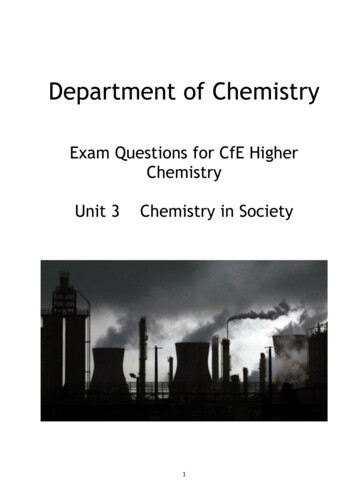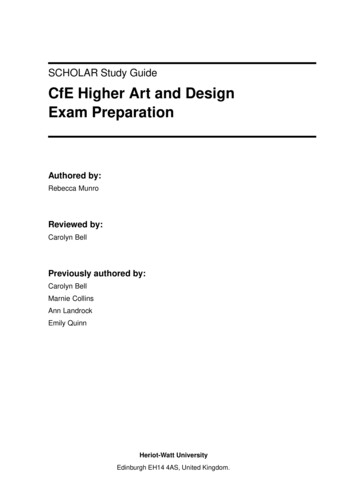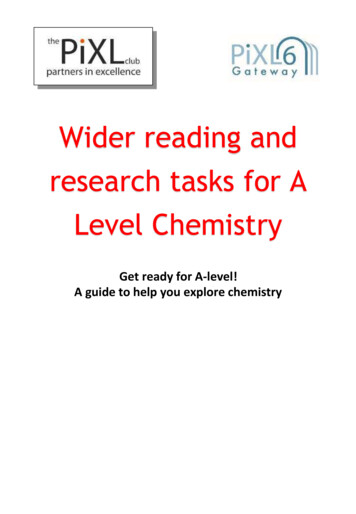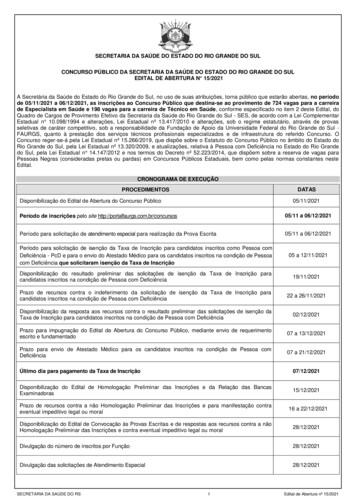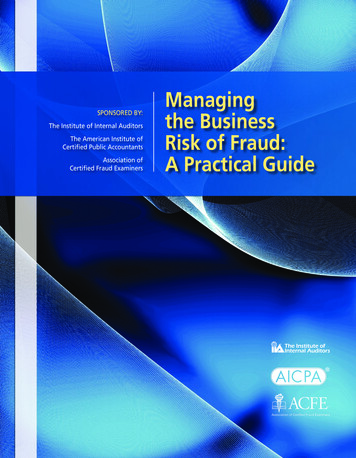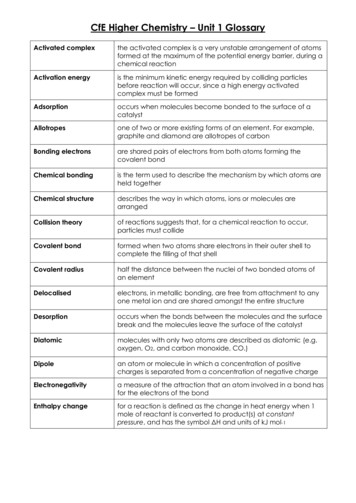
Transcription
CfE Higher Chemistry – Unit 1 GlossaryActivated complexthe activated complex is a very unstable arrangement of atomsformed at the maximum of the potential energy barrier, during achemical reactionActivation energyis the minimum kinetic energy required by colliding particlesbefore reaction will occur, since a high energy activatedcomplex must be formedAdsorptionoccurs when molecules become bonded to the surface of acatalystAllotropesone of two or more existing forms of an element. For example,graphite and diamond are allotropes of carbonBonding electronsare shared pairs of electrons from both atoms forming thecovalent bondChemical bondingis the term used to describe the mechanism by which atoms areheld togetherChemical structuredescribes the way in which atoms, ions or molecules arearrangedCollision theoryof reactions suggests that, for a chemical reaction to occur,particles must collideCovalent bondformed when two atoms share electrons in their outer shell tocomplete the filling of that shellCovalent radiushalf the distance between the nuclei of two bonded atoms ofan elementDelocalisedelectrons, in metallic bonding, are free from attachment to anyone metal ion and are shared amongst the entire structureDesorptionoccurs when the bonds between the molecules and the surfacebreak and the molecules leave the surface of the catalystDiatomicmolecules with only two atoms are described as diatomic (e.g.oxygen, O2, and carbon monoxide, CO.)Dipolean atom or molecule in which a concentration of positivecharges is separated from a concentration of negative chargeElectronegativitya measure of the attraction that an atom involved in a bond hasfor the electrons of the bondEnthalpy changefor a reaction is defined as the change in heat energy when 1mole of reactant is converted to product(s) at constantpressure, and has the symbol ΔH and units of kJ mol-1
Fullerenesare molecules of pure carbon constructed from 5- and 6membered rings combined into hollow structures. The moststable contains 60 carbon atoms in a shape resembling afootballHydrogen bondsare electrostatic forces of attraction between moleculescontaining a hydrogen atom bonded to an atom of a stronglyelectronegative element such as fluorine, oxygen or nitrogen,and a highly electronegative atom on a neighbouring moleculeIntermolecular forcesare those which attract molecules together. They are weakerthan chemical bondsIntramolecular forcesare forces of attraction which exist within a moleculeIonisation energythe energy required to remove one mole of electrons from onemole of atoms in the gaseous stateIsoelectronicmeans having the same arrangement of electrons. For example,the noble gas neon, a sodium ion (Na ) and a magnesium ion(Mg2 ) are isoelectronicLatticea lattice is a regular 3D arrangement of particles in space. Theterm is applied to metal ions in a solid, and to positive andnegative ions in an ionic solidLondon dispersionforcesthe forces of attraction which result from the electrostaticattraction between temporary dipoles and induced dipolescaused by movement of electrons in atoms and moleculesLone pairsare pairs of electrons in the outer shell of an atom which take nopart in bondingMisciblefluids are fluids which mix with or dissolve in each other in allproportionsPeriodicityis the regular recurrence of similar properties when the elementsare arranged in order of increasing atomic numberPolar covalent bonda covalent bond between atoms of different electronegativity,which results in an uneven distribution of electrons and a partialcharge along the bondPotential energydiagramshows the enthalpy of reactants and products, and the enthalpychange during a chemical reactionPropertiesof a substance are their physical and chemical characteristics.These are often a reflection of the chemical bonding andstructure of the material.Thermochemicalequationstates the enthalpy change for the reaction defined, withreactants and products inthe states shownViscosityis the resistance to flow that is exhibited by all liquids
CfE Higher Chemistry – Unit Two - Summary1) Esters An ester can be identified from the ester group and by the name containingthe -‘yl-oate’ endings. An ester can be named given the names of the parent carboxylic acid andalcohol or from structural formulae. Structural formulae for esters can be drawn given the names of the parentalcohol and carboxylic acid or the names of esters. Esters have characteristic smells and are used as flavourings and fragrances. Esters are also used as industrial solvents. Esters are formed by the condensation reaction between carboxylic acidand an alcohol. The ester link is formed by the reaction of a hydroxyl groupand the carboxyl group. In condensation reactions, the molecules join together with the elimination ofa small molecule, in this case water. Esters can be hydrolysed to produce a carboxylic acid and alcohol. Given the name of an ester or its structural formula, the hydrolysis productscan be named and their structural formulae drawn. The parent carboxylic acid and the parent alcohol can be obtained by hydrolysis of an ester. In a hydrolysis reaction, a molecule reacts with waterbreaking down into smaller molecules2) Fats and Oils Fats and oils are a concentrated source of energy. Fats and oils can be classified as animal, vegetable or marine. Fats and oils are important in a balanced diet and supply the body with energy in a more concentrated form than carbohydrates. There is evidence of alink between a high intake of saturated fat in the diet and heart disease. Fatsand oils are essential for the transport and storage of fat-soluble vitamins inthe body. The lower melting points of oils compared to those of fats is related to thehigher degree of unsaturation of oil molecules. The low melting points of oilsare a result of the effect that the shapes of the molecules have on closepacking, hence on the strength of van der Waals’ forces of attraction. Fats and oils are esters formed from the condensation of glycerol (propane1,2,3-triol) and three carboxylic acid molecules. The carboxylic acids are known as ‘fatty acids’ and are saturated or unsaturated straight-chain carboxylic acids, usually with long chains of carbon atoms. Bromine solution can be used to test fats and oils for the degree of unsaturation. The higher the unsaturation levels the lower the melting point. The hydrolysis of triglycerides produces one molecule of glycerol (a trihydricalcohol) and three molecules of fatty acids which can be identical to or different from each other. The fatty acids produced can be saturated or unsaturated and always contain even numbers of carbon atoms C4 to C24, primarily C16 and C18. The conversion of oils into hardened fats involves the partial removal of unsaturation by the addition of hydrogen.
3) Proteins Nitrogen is essential for protein formation by plants and animals. Proteins are the major structural materials of animal tissue. Proteins are also involved in the maintenance and regulation of life processes. Enzymes are proteins. The structure of a section of protein is based on the constituent amino acids. Amino acids, the building blocks from which proteins are formed, are relatively small molecules which all contain an amino group (NH2), and a carboxyl group (COOH). The body cannot make all the amino acids required for body proteins and isdependent on dietary protein for supply of certain amino acids known as essential amino acids. Proteins are made of many amino acid molecules linked together by condensation reactions. Condensation polymers are made from monomers with two functional groupsper molecule. A small molecule is also produced as condensation occurs. In these condensation reactions, the amino group on one amino acid andthe carboxyl group on a neighbouring amino acid join together, with theelimination of water. The link which forms between the two amino acids can be recognised as anamide link (CONH) also known as the peptide link when in living things. Proteins which fulfil different roles in the body are formed by linking differingsequences of amino acids together. During digestion, enzyme hydrolysis of dietary proteins can produce aminoacids. The structural formulae of amino acids obtained from the hydrolysis of proteinscan be identified from the structure of a section of the protein. Chromatography can separate and identify these amino acids by comparison with a bank of known amino acids.4) Chemistry of Cookinga) Flavour Molecules: the olfactory and taste senses in humans can be described; food flavours mainly excite the senses of taste and smell; molecular size and functional groups present affect the volatility of foodmolecules; flavour molecules can be water- or oil-soluble, consequently cooking methods can affect the quality of the food; cooking methods might enhance or destroy the food's flavour; cooking changes (denatures) proteins, in particular it can make tough collagen palatable; different cooking methods would be appropriate for different foodsb) Proteins within proteins, the long-chain molecules may be twisted to form spirals,folded into sheets, or wound around to form other complex shapes; the chains are held in these forms by intermolecular bonding between theside chains of the constituent amino acids;
when proteins are heated, during cooking, these intermolecular bonds arebroken allowing the proteins to change shape (denature). these changes alter the texture of foods.5) Oxidation of Food When applied to carbon compounds, oxidation reactions result in an increase in the oxygen to hydrogen ratio.a) Oxidation of alcohols Primary and secondary alcohols can be oxidised by a number of oxidisingagents, including copper(II) oxide and acidified potassium dichromate. Primary alcohols are oxidised first to aldehydes and then to carboxylic acids.Secondary alcohols are oxidised to ketones. Tertiary alcohols are resistant to oxidation.b) Aldehydes and ketones Alkanals and alkanones are homologous series of aldehydes and ketones respectively, identified by the presence of the carbonyl functional group. Theyare named in a similar way to alkanols. Aldehydes and ketones can be identified from the ‘-al’ and ‘-one’ nameendings respectively. Straight-chain and branched-chain aldehydes and ketones, with no morethan eight carbon atoms in their longest chain, can be named from structuralformulae. Given the names of straight-chain or branched-chain aldehydes and ketones, structural formulae can be drawn and molecular formulae written.c) Oxidation of food molecules Aldehydes, but not ketones, can be oxidised to carboxylic acids. Fehling’s solution, Tollens’ reagent and acidified dichromate solution can beused to differentiate between an aldehyde and a ketone.d) Antioxidants Oxygen reacts with edible oils giving the food a rancid flavour. Antioxidants are molecules which will prevent these oxidation reactions takingplace. Ion-electron equations can be written for the oxidation of many antioxidantsElements are arranged in the Periodic Table in order of increasing atomicnumber.6) Soaps, detergents and emulsionsa) Soaps production of soaps by the alkaline hydrolysis of fats and oils to form watersoluble ionic salts called soaps; soap ions have a long covalent tail, readily soluble in covalent compounds(hydrophobic), and an ionic carboxylate head which is negatively chargedand water soluble (hydrophilic); during cleaning using soaps and detergents, the hydrophobic tails dissolve ina droplet of oil or grease, whilst the hydrophilic heads face out into the surrounding water; agitation of the mixture results in ball-like structure forming with the hydrophobic tails on the inside and the negative hydrophilic head on the outside;
repulsion between these negative charges results in an emulsion beingformed and the dirt released;b) Detergents detergents are particularly useful in hard water areas;c) Emulsions an emulsion contains small droplets of one liquid dispersed in another liquid.Emulsions in food are mixtures of oil and water; to prevent oil and water components separating into layers, a soap-likemolecule known as an emulsifier is added; emulsifiers for use in food are commonly made by reacting edible oils withglycerol to form molecules in which either one or two fatty acid groups arelinked to a glycerol backbone rather than the three normally found in edibleoils; the one or two hydroxyl groups present in these molecules are hydrophilicwhilst the fatty acid chains are hydrophobic; when applied to carbon compounds, reduction reactions result in a decrease in the oxygen to hydrogen ratio7) Fragrancesa) Essential oils essential oils are concentrated extracts of the volatile, non-water solublearoma compounds from plants; essential oils can be extracted from suitable plant sources by steam distillationor solvent extraction; essential oils are widely used in perfumes, cosmetic products, cleaning products and as flavourings in foods; essential oils are mixtures of organic compounds; terpenes are key components in most essential oils;b) Terpenes terpenes are unsaturated compounds formed by joining together isoprene (2methylbuta-1,3-diene) units; terpenes are components in a wide variety of fruit and floral flavours andaromas; terpenes can be oxidised within plants to produce some of the compoundsresponsible for the distinctive aroma of spices8) Skin Carea) UV radiation ultraviolet radiation (UV) is a high-energy form of light, present in sunlight; exposure to UV light can result in molecules gaining sufficient energy forbonds to be broken; this is the process responsible for sunburn and also contributes to aging of theskin; sun-block products prevent UV light reaching the skin;b) Free radicals when UV light breaks bonds, free radicals are formed;
free radicals have unpaired electrons and, as a result, are highly reactive; free radical chain reactions include the following steps: initiation, propagation and termination;c) Free radical scavengers many cosmetic products contain free radical scavengers; free radical scavengers are also added to food products and to plastics.CfE Higher Chemistry – Unit Three - Summary1) Getting the most from reactantsa) The chemical industry Industrial processes are designed to maximise profit and minimise theimpact on the environment. Factors influencing process design include: availability, sustainabilityand cost of feedstock(s); opportunities for recycling; energy requirements; product yield; marketability of by-products. Environmental considerations include: minimising waste; avoiding theuse or production of toxic substances; designing products which willbiodegrade if appropriate.b) Chemical calculations Balanced equations show the mole ratio(s) of reactants and products. Using the balanced equation and the gram formula masses(GFM), mass to mass calculations can be performed. The quantity of a reactant or product can also be expressed in termsof moles.The concentration of a solution can be expressed in mol l-1. Balanced equations can be used in conjunction with concentrationsand volumes of solutions and/or masses of solutes to determine quantities of reactants and/or products.c) Molar volume The molar volume (in units of litres mol-1) is the same for all gases atthe same temperature and pressure. The volume of a gas can becalculated from the number of moles and vice versa. The volumes of reactant and product gases can be calculated fromthe number of moles of each reactant and product.d) Percentage yield The efficiency with which reactants are converted into the desiredproduct is measured in terms of the percentage yield and atomeconomy. Percentage yields can be calculated from mass of reactant(s) andproduct(s) using a balanced equation. Given costs for the reactants, a percentage yield can be used to calculate the feedstock’s cost for producing a given mass of product.e) Atom economy
The atom economy measures the proportion of the total mass of allstarting materials successfully converted into the desired product. It can be calculated using the formula shown below in which themasses of products and reactants are those appearing in the balanced equation for the reaction. Atom Economy (mass of desired product(s) / total mass of reactants) x 100. Reactions which have a high percentage yield may have a low atomeconomy value if large quantities of unwanted by-products areformed.f) Excess In order to ensure that costly reactant(s) are converted into product,an excess of less expensive reactant(s) can be used. By considering a balanced equation, the limiting reactant and thereactant(s) in excess can be identified. Whilst the use of excess reactants may help to increase percentageyields, this will be at the expense of the atom economy so an economic / environmental balance must be struck.2) Chemical Equilibria Many reactions are reversible, so products may be in equilibrium withreactants. At equilibrium, the concentrations of reactants and products remainconstant, but are rarely equal. This may result in costly reactants failing to be completely convertedinto products. In a closed system, reversible reactions attain a state of dynamicequilibrium when the rates of forward and reverse reactions areequal. Le Chatelier's principle states that if the conditions of a chemical system at equilibrium are changed, the system responds by minimisingthe effect of the changes. Changes in concentration, pressure and temperature can alter theposition of equilibrium. To maximise profits, chemists employ strategies to move the position ofequilibrium in favour of products. A catalyst increases the rate of attainment of equilibrium but does notaffect the position of equilibrium. The effects of altering pressure, altering temperature, the addition or removal of reactants or productscan be predicted for a given reaction.3) Chemical energya) Chemical energy For industrial processes, it is essential that chemists can predict thequantity of heat energy taken in or given out. If reactions are endothermic, costs will be incurred in supplying heatenergy in order to maintain the reaction rate.
If reactions are exothermic, the heat produced may need to be removed to prevent the temperature rising.b) Enthalpy Chemical energy is also known as enthalpy. The change in chemical energy associated with chemical reactionscan be measured. The specific heat capacity, mass and temperaturecan be used to calculate the enthalpy change for a reaction. The enthalpy of combustion of a substance is the enthalpy changewhen one mole of the substance burns completely in oxygen. These values can often be directly measured using a calorimeter andvalues for common compounds are available from data books andonline databases for use in Hess’s law calculations.c) Hess’s law Hess’s law states that the enthalpy change for a chemical reaction isindependent of the route taken. Enthalpy changes can be calculated by applying Hess’s law.d) Bond enthalpies For a diatomic molecule, XY, the molar bond enthalpy is the energyrequired to break one mole of XY bonds. Mean molar bond enthalpies are average values which are quotedfor bonds which occur in different molecular environments. Bond enthalpies can be used to estimate the enthalpy change occurring for a gas phase reaction by calculating the energy requiredto break bonds in the reactants and the energy released when newbonds are formed in the products.4) Oxidising or reducing agentsa) Elements as oxidising or reducing agents A redox reaction is a reaction in which reduction and oxidation occurtogether, reduction being the gain of electrons by a reactant andoxidation being the loss of electrons by a reactant in a reaction. An oxidising agent is a substance which accepts electrons. A reducing agent is a substance which donates electrons. Oxidising and reducing agents can be identified in redox reactions. Elements with low electronegativities (metals) tend to form ions by losing electrons (oxidation) and so can act as reducing agents. The strongest reducing agents are found in Group 1. Elements with high electronegativities (non-metals) tend to form ionsby gaining electrons (reduction) and so can act as oxidising agents. The strongest oxidising agents come from Group 7. The electrochemical series indicates the effectiveness of oxidising andreducing agents.b) Compounds as oxidising or reducing agents Compounds can also act as oxidising or reducing agents. Electrochemical series contain a number of ions and molecules.
The dichromate and permanganate ions are strong oxidising agentsin acidic solutions whilst hydrogen peroxide is an example of a molecule which is a strong oxidising agent. Carbon monoxide is an example of a gas that can be used as a reducing agent. Oxidising and reducing agents can be selected using an electrochemical series from a data booklet or can be identified in the equation showing a redox reaction.c) Use of oxidising agents Oxidising agents are widely employed because of the effectivenesswith which they can kill fungi and bacteria, and can inactivate viruses. The oxidation process is also an effective means of breaking downcoloured compounds making oxidising agents ideal for use as‘bleach’ for clothes and hair.d) Ion-electron equations Oxidation and reduction reactions can be represented by ionelectron equations. When molecules or group ions are involved, if the reactant and product species are known, a balanced ion-electron equation can bewritten by adding appropriate numbers of water molecules, hydrogen ions and electrons. Ion-electron equations can be combined to produce redox equations.e) Practical applications Displacement reactions are example of redox reactions and oxidisingand reducing agents can be identified in these and other redox reactions. The technique of titration can be applied to redox reactions, allowingthe concentration of a reactant to be calculated from results ofvolumetric titrations. A potential energy diagram can be used toshow the energy pathway for a reaction.5) Chemical Analysisa) Chromatography in chromatography, differences in the polarity / size of molecules areexploited to separate the components present within a mixture; depending on the type of chromatography in use, the identity of acomponent can be indicated either by the distance it has travelledor by the time it has taken to travel through the apparatus (retentiontime); the results of a chromatography experiment can sometimes be presented graphically showing an indication of the quantity of substancepresent on the y-axis and retention time on the x-axis.Note: Learners are not required to know the details of any specificchromatographic method or experimentb) Volumetric analysis
volumetric analysis involves using a solution of accurately known concentration in a quantitative reaction to determine the concentration of anothersubstance; a solution of accurately known concentration is known as a standardsolution; the volume of reactant solution required to complete the reaction isdetermined by titration; calculations from balanced equations can then be carried out tocalculate the concentration of the unknown solution; redox titrations are based on redox reactions; substances such as potassium permanganate(VII), which can act astheir own indicators, are very useful reactants in redox titrations; the concentration of a substance can be calculated from experimental results by use of a balanced equation
CfE Higher Chemistry - Unit Two - Summary 1) Esters An ester can be identified from the ester group and by the name containing the -'yl-oate' endings. An ester can be named given the names of the parent carboxylic acid and alcohol or from structural formulae. Structural formulae for esters can be drawn given the names of the parent .


